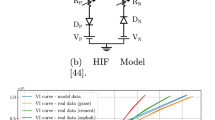Abstract
In this paper, a novel intervals-based distribution short-circuit calculation algorithm is proposed. In distribution networks, there are various renewable energy-based generators (solar panels, wind generators, small hydro turbines, etc.), as well as loads with uncertain generation and consumption. Therefore, short-circuit calculation has to consider all these uncertainties. The algorithm proposed in this paper deals with above-mentioned uncertainties, as well as correlations among them. Algorithm testing is performed on two test examples of distribution networks, 6-bus and 1003-bus, for the verification of its robustness and efficiency on real-life, large-scale systems. The results demonstrate that the proposed algorithm provides highly accurate results and that it is able to solve real-life short-circuit problems with a higher precision than the traditional deterministic short-circuit calculation algorithms.

















Similar content being viewed by others
Notes
In the 6-bus test example, line’s shunt admittances are neglected due to the simplicity of the example. The proposed algorithm dealing with line’s shunt admittances and 1003-bus real-world test example has line’s shunt admittances.
References
Anderson PM (1995) Analysis of faulted power systems. IEEE Press, New York
Bergen AR, Vittal V (2000) Power system analysis, 2nd edn. Prentice Hall, Englewood Cliffs
Strezoski VC, Bekut DD (1991) A canonical model for the study of faults in power systems. IEEE Trans Power Syst 4:1493–1499. https://doi.org/10.1109/59.116995
Jabr RA, Dzafic I (2015) A Fortescue approach for real-time short circuit computation in multiphase distribution networks. IEEE Trans Power Syst 6:3276–3285. https://doi.org/10.1109/TPWRS.2014.2376198
Lacroix JS, Kocar I, Belletête M (2013) Accelerated computation of multiphase short circuit summary for unbalanced distribution systems using the concept of selected inversion. IEEE Trans Power Syst 2:1515–1522. https://doi.org/10.1109/TPWRS.2012.2209462
Tu DV, Chaitusaney S, Yokoyama A (2014) Maximum-allowable distributed generation considering fault ride-through requirement and reach reduction of utility relay. IEEE Trans Power Deliv 2:534–541. https://doi.org/10.1109/TPWRD.2013.2279803
Strezoski LV, Prica MD (2016) Real-time short-circuit analysis of active distribution systems. In: IEEE power and energy conference at Illinois (PECI), Champagne, IL. https://doi.org/10.1109/PECI.2016.7459252
Strezoski VC, Vidović PM (2015) Power flow for general mixed distribution networks. Int Trans Electr Energy Syst 10:2455–2471. https://doi.org/10.1002/etep.1974
Shirmohammadi D, Hong HW, Semlyen A, Luo GX (1988) A compensation-based power flow method for weakly meshed distribution and transmission networks. IEEE Trans Power Syst 2:753–762. https://doi.org/10.1109/59.192932
Zhang X, Soudi F, Shirmohammadi D, Cheng CS (1995) A distribution short circuit analysis approach using hybrid compensation method. IEEE Trans Power Syst 4:2053–2059. https://doi.org/10.1109/59.476075
Lin WM, Ou TC (2011) Unbalanced distribution network fault analysis with hybrid compensation. IET Gener Transm Distrib 1:92–100. https://doi.org/10.1049/iet-gtd.2008.0627
Sulla F, Svensson J, Samuelsson O (2011) Symmetrical and unsymmetrical short-circuit current of squirrel-cage and doubly-fed induction generators. Electr Power Syst Res 7:1610–1618. https://doi.org/10.1016/j.epsr.2011.03.016
Howard DF, Smith TM, Starke M, Harley RG (2012) Short circuit analysis of induction machines—wind power application. In: IEEE transmission and distribution conference and exposition, Orlando, FL. https://doi.org/10.1109/TDC.2012.6281643
Joint Working Group (2015) Fault current contribution from wind plants. IEEE Power Energy Soc. https://doi.org/10.1109/CPRE.2015.7102165
Gao F, Iravani MR (2008) A control strategy for a distributed generation unit in grid-connected and autonomous modes of operation. IEEE Trans Power Deliv 2:850–859. https://doi.org/10.1109/TPWRD.2007.915950
IEC 60909-0:2016 (2016) Short-circuit currents in three-phase a. c. systems—part 0: calculation of currents
Strezoski LV, Prica MD, Loparo KA (2017) Generalized Δ-circuit concept for integration of distributed generators in online short-circuit calculations. IEEE Trans Power Syst 4:3237–3245. https://doi.org/10.1109/TPWRS.2016.2617158
Zhang N, Kang C, Duan C, Tang X, Huang J, Lu Z, Wang W, Qi J (2010) Simulation methodology of multiple wind farms operation considering wind speed correlation. Int J Power Energy Syst 4:264–273. https://doi.org/10.2316/Journal.203.2010.4.203-4843
Zhang N, Kang C, Xu Q, Jiang C, Chen Z, Liu J (2013) Modelling and simulating the spatio-temporal correlations of clustered wind power using copula. J Electr Eng Technol 6:1615–1625. https://doi.org/10.5370/JEET.2013.8.6.1615
Maya KN, Jasmin EA (2016) Optimal integration of distributed generation (DG) resources in unbalanced distribution system considering uncertainty modelling. Int Trans Electr Energy Syst 1:e2248. https://doi.org/10.1002/etep.2248
Ruiz-Rodriguez FJ, Hernández JC, Jurado F (2017) Voltage behaviour in radial distribution systems under the uncertainties of photovoltaic systems and electric vehicle charging loads. International Transactions on Electrical Energy Systems 2:e2490. https://doi.org/10.1002/etep.2490
Carmona MC, Behnike RP, Estevez GJ (2010) Fuzzy arithmetic for the DC load flow. IEEE Trans Power Syst 1:206–214. https://doi.org/10.1109/TPWRS.2009.2030350
Weng Z, Shi L, Xu Z, Lu Q, Yao L, Ni Y (2014) Fuzzy power flow solution considering wind power variability and uncertainty. Int Trans Electr Energy Syst 3:547–572. https://doi.org/10.1002/etep.1871
Bijwe PR, Raju GKV (2006) Fuzzy distribution power flow for weakly meshed systems. IEEE Trans Power Syst 4:1645–1652. https://doi.org/10.1109/TPWRS.2006.881138
Yu H, Rosehart WD (2012) An optimal power flow algorithm to achieve robust operation considering load and renewable generation uncertainties. IEEE Trans Power Syst 4:1808–1817. https://doi.org/10.1109/TPWRS.2012.2194517
Bagheri A, Monsef H, Lesan H (2015) Evaluating the effects of renewable and nonrenewable DGs on DNEP from the reliability, uncertainty, and operational points of view by employing hybrid GA and OPF. Int Trans Electr Energy Syst 12:3304–3328. https://doi.org/10.1002/etep.2037
Wang Y, Zhang N, Chen Q, Yang J, Kang C, Huang J (2016) Dependent discrete convolution based probabilistic load flow for the active distribution system. IEEE Trans Sustain Energy 3:1000–1009. https://doi.org/10.1109/TSTE.2016.2640340
Vidović PM, Sarić AT (2017) A novel correlated intervals-based algorithm for distribution power flow calculation. Int J Electr Power Energy Syst 90:245–255. https://doi.org/10.1016/j.ijepes.2016.12.019
Piegat A, Landowski M (2012) Is the conventional interval arithmetic correct? J Theor Appl Comput Sci 2:27–44
Piegat A, Landowski M (2013) Two interpretations of multidimensional RDM interval arithmetic-multiplication and division. Int J Fuzzy Syst 4:488–496
Moore RE (1966) Interval analysis. Prentice-Hall, Englewood Cliffs
Begović MM (2013) Electrical transmission systems and smart grids. Springer, New York
Ranković A, Maksimović BM, Sarić AT, Lukič U (2014) ANN-based correlation of measurements in micro-grid state estimation. Int Trans Electr Energy Syst 10:2181–2202. https://doi.org/10.1002/etep.1956
Garcia PAN, Pereira JLR, Carneiro S Jr, da Costa VM, Martins N (2000) Three-phase power flow calculations using the current injection method. IEEE Trans Power Syst 2:508–514. https://doi.org/10.1109/59.867133
Strezoski LV, Katic V, Dumnic B, Prica MD (2016) Short-circuit modeling of inverter based distributed generators considering the FRT requirements. In: IEEE North American power symposium (NAPS), Denver, CO, USA, Sept 18–20, 2016. https://doi.org/10.1109/NAPS.2016.7747900
Luo GX, Semlyen A (1990) Efficient load flow for large weekly meshed networks. IEEE Trans Power Syst 4:1309–1316. https://doi.org/10.1109/59.99382
Rodgers JL, Nicewander WA (1988) Thirteen ways to look at the correlation coefficient. Am Stat 42:59–66. https://doi.org/10.1080/00031305.1988.10475524
Acknowledgements
This work was supported by the Ministry of Education, Science and Technological Development, Serbia and Schneider Electric DMS NS, Serbia, under the Project III-42004.
Author information
Authors and Affiliations
Corresponding author
Additional information
Publisher's Note
Springer Nature remains neutral with regard to jurisdictional claims in published maps and institutional affiliations.
Appendixes
Appendixes
1.1 Appendix A
For DG (photovoltaic or wind) and load, active power is analyzed when weather parameters (from historical database and/or forecasted ones) are changed. The following time-dependent inputs are used for simulations: solar radiation, solar elevation, air temperature, wind speed, wind direction, and atmospheric pressure.
Weather data are classified by using the Self-Organization Map Artificial Neural Network (SOM ANN), where the SOM ANN represents a clustering concept with self-organizing characteristics that can efficiently group different input patterns. The correlation coefficients between dependent inputs are calculated from clustered weather data and corresponding powers from DG units or loads, where the feedforward artificial neural networks (FF ANNs) with back propagation are used for approximating the output active power of unmonitored elements. For details about the applied methodology, see [33].
In this paper, correlation coefficients are calculated from weather data (from weather historical database and/or forecasted values) classified into the winning neuron of the SOM ANN and subsequently from the corresponding internal active powers of DG units and output active powers of loads obtained by FF ANNs. The correlation coefficient between ath and bth inputs classified into the winning neuron is as follows:
where the covariance between ath and bth inputs (za and zb, respectively) in (7.1.1) can be calculated from the set of input samples as [37]:
where N is the number of samples for a (b)th input, while the mean value for the set of a (b)th input samples is:
Standard deviation for a (b)th input in (7.1.1) is as follows:
1.2 Appendix B
The following equations, in the complex numbers form, present the short-circuit calculation in the ∆-circuit in the bus k:
Single phase
Two phases
Two phases with ground
Three phases
Rights and permissions
About this article
Cite this article
Obrenić, M.Z., Vidović, P.M. & Strezoski, L.V. A novel intervals-based algorithm for the distribution short-circuit calculation. Electr Eng 101, 1145–1162 (2019). https://doi.org/10.1007/s00202-019-00853-2
Received:
Accepted:
Published:
Issue Date:
DOI: https://doi.org/10.1007/s00202-019-00853-2




